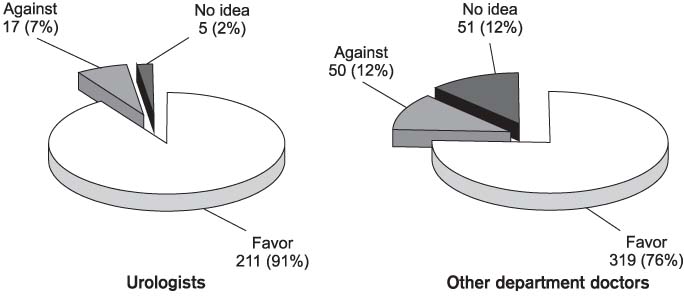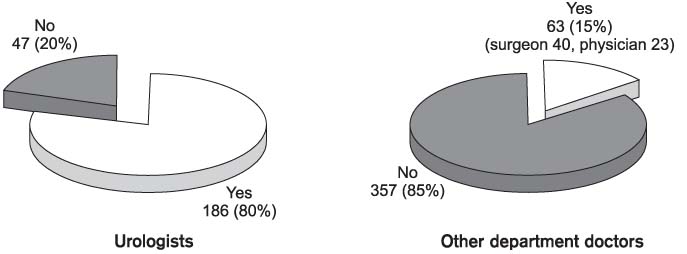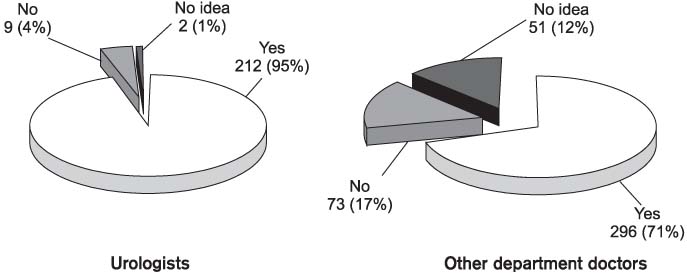Korean J Urol.
2006 Jan;47(1):91-96. 10.4111/kju.2006.47.1.91.
What are Doctors' Clinical Opinions Regarding Circumcision?
- Affiliations
-
- 1Department of Urology, Chonnam National University Medical School, Gwangju, Korea. sbryu@chonnam.ac.kr
- KMID: 2294222
- DOI: http://doi.org/10.4111/kju.2006.47.1.91
Abstract
-
PURPOSE: Circumcision is widely practiced in Korea, but the general principles of circumcision are not established. To date, several studies on the public's attitude regarding circumcision have been reported, but there have been few studies on doctor's opinions. This study was designed to evaluate the difference of clinical opinion regarding circumcision between the doctors in South Korea.
MATERIALS AND METHODS
A questionnaire was sent to the doctors working in university hospitals and primary clinics. The items of the questionnaire were for and against circumcision, the actual clinical practice of circumcision, the recommendation of circumcision, the reasons for it and the difficulties in practicing circumcision.
RESULTS
Of the 1,000 questionnaires we sent out, 725 were returned. Of 233 urologists, 211 (91%) agreed with performing circumcision and of the 420 doctor of other department, 319 (76%) agreed with performing circumcision. A total of 530 doctors (81%) agreed with performing circumcision. Both the urologists and the doctors practicing in other departments selected hygiene as the reason for practicing circumcision, 155 (73%) and 254 (86%), respectively. The responses to the questionnaire revealed corresponding opinions regarding circumcision between the urologists and doctors of other departments.
CONCLUSIONS
Most Korean men were found to be circumcised and they were very much satisfied with the results. In other countries, there was a difference in clinical opinions between doctors concerning circumcision; however, Korean doctors revealed a corresponding opinion regarding circumcision.
Keyword
MeSH Terms
Figure
Cited by 1 articles
-
A New Convenient Device of Circumcision
Jae Hung Jung, Sang Bong Lee, Jae Mann Song
Korean J Urol. 2006;47(10):1099-1102. doi: 10.4111/kju.2006.47.10.1099.
Reference
-
1. Oh SJ, Kim KD, Kim KM, Kim KS, Kim KK, Kim JS, et al. Knowledge and attitude of Korean parents towards their son's circumcision: a nationwide questionnaire study. BJU Int. 2002. 89:426–432.2. Warner E, Strashin E. Benefits and risks of circumcision. Can Med Assoc J. 1981. 125:967–976.3. Dunsmuir WD, Gordon EM. The history of circumcision. BJU Int. 1999. 83:Suppl 1. 1–12.4. American Academy of Pediatrics. Task force on circumcision. Circumcision policy statement. Pediatrics. 1999. 103:686–693.5. The case against neonatal circumcision. Br Med J. 1979. 1:1163–1164.6. Nelson CP, Dunn R, Wan J, Wei JT. The increasing incidence of newborn circumcision: data from the nationwide inpatient sample. J Urol. 2005. 173:978–981.7. Kim TH, Oh SJ, Choi H. Knowledge and attitude toward circumcision in Korean: a questionnaire study stratified by age. Korean J Urol. 2002. 43:786–794.8. Ryu SB, Kim KW, Kwon DD. Study on consciousness of Korean adults for circumcision. Korean J Urol. 2003. 44:561–569.9. Cherpes TL, Meyn LA, Krohn MA, Hillier SL. Risk factors for infection with herpes simplex virus type 2: role of smoking, douching, uncircumcised males, and vaginal flora. Sex Transm Dis. 2003. 30:405–410.10. Schoen EJ, Oehrli M, Colby C, Machin G. The highly protective effect of newborn circumcision against invasive penile cancer. Pediatrics. 2000. 105:E36.11. Castellsague X, Bosch FX, Munoz N, Meijer CJ, Shan KV, de Sanjose S, et al. Male circumcision, penile human papillomavirus infection, and cervical cancer in female partners. N Engl J Med. 2002. 346:1105–1112.12. Fink KS, Carson CC, DeVellis RF. Adult circumcision outcomes study: effect on erectile function, penile sensitivity, sexual activity and satisfaction. J Urol. 2002. 167:2113–2116.13. Risser JM, Risser WL, Eissa MA, Cromwell PF, Barratt MS, Bortot A. Self-assessment of circumcision status by adolescents. Am J Epidemiol. 2004. 159:1095–1097.14. Kaplan GW. Complications of circumcision. Urol Clin North Am. 1983. 10:543–549.15. Demirseren ME, Gokrem S. Circumcision in unqualified hands: a significant risk of complication. Plast Reconstr Surg. 2004. 113:1090–1092.16. Bloom DA, Koo HP. The circumcision issue. Clin Pediatr. 1999. 38:243–244.17. Howard CR, Howard FM, Garfunkel LC, de Blieck EA, Weitzman M. Neonatal circumcision and pain relief: current training practices. Pediatrics. 1998. 101:423–428.18. Alanis MC, Lucidi RS. Neonatal circumcision: a review of the world`s oldest and most controversial operation. Obstet Gynecol Surv. 2004. 59:379–395.19. Adler R, Ottaway MS, Gould S. Circumcision: We have heard from the experts; now let's hear from the parents. Pediatrics. 2001. 107:E20.20. Okino BM, Yamamoto LG. Survey of internet web sites on circumcision. Clin Pediatr. 2004. 43:667–669.21. Farshi Z, Atkinson KR, Squire R. A study of clinical opinion and practice regarding circumcision. Arch Dis Child. 2000. 83:393–396.22. Pang MG, Kim DS. Extraordinarily high rates of male circumcision in South Korea: history and underlying causes. BJU Int. 2002. 89:48–54.
- Full Text Links
- Actions
-
Cited
- CITED
-
- Close
- Share
- Similar articles
-
- Study on Consciousness of Korean Adults for Circumcision
- A Questionnaire Study Concerning Circumcision of Elementary School Boys in the City of Gwangju
- Complication of Circumcision Performed with Mechanical Self-Circumcision Device: A Case Report
- Male Circumcision: Is It the Proper Treatment or Not?
- A Convenient Device of Circumcision






